On land, on water… and on carrier decks! Grumman’s great J2F Duck
The Grumman J2F-5 Duck
The end of the twenties and the beginning of the thirties produced a whole series of interesting aircraft designs, whose attraction from today's perspective lies in their character as technical hybrids. In those days, the tried and tested design concepts of the first two decades of aviation were reaching their limits: the aerodynamics of the bi- or multi-plane aircraft had been exhausted, open cockpits and rigid undercarriages were moving from being the standard without alternative to being more and more of a stumbling block when it came to being able to push performance even further.
Advances in engine development as well as in metal processing demanded new concepts in order to fully develop their potential. The Grumman Duck, which first flew in 1933, provides a good example of this transitional period. Equipped with a 1050 hp P&W R 1820-54 radial engine, the design was still a biplane, but featured retractable landing gear and an aluminium-covered fuselage. The crew of three sat in a completely enclosed cockpit or fuselage. The wings and all rudders were still fabric-covered.
Despite its bulky appearance, the powerful engine made the Duck the fastest biplane in the arsenal of the US armed forces. Its real reputation, however, was built on its versatility: as an amphibious aircraft, it was unrestrictedly suitable for operations from land as well as for take-offs and landings in the water. The tail-mounted arresting hook indicates that the Duck could also be used as a carrier aircraft; a practice often used, incidentally. In this respect, too, the design proved to be a true hybrid.
The central float integrated into the fuselage places the design in an interesting and not often played niche between seaplane and flying boat, while the design makes the contours of the land plane mounted on the float easy to follow. This formal hybridisation makes the Grumman Duck quite unique, a comparable aircraft will not be found so soon.
This unique appearance is mainly due to the inventive genius of Grover Loening, an aircraft designer who had been quite successful since the 10s and had close business ties to Leroy Grumman.
Loening had already developed the "Loening OL" at the beginning of the 1920s, a flying boat that was to show all the characteristics of the later Grumman Duck. It is really worth a look into the picture archives to see how consistently Loening pursued the ideas of the float integrated into the fuselage in combination with a retractable undercarriage to finally bring them to a crowning conclusion in the Grumman Duck.
The Grover Loening Aircraft Company, founded by Loening in 1928, was staffed by Leroy Grumman, William T. Schwendler and Jake Swirbul, the personalities who were to found the Grumman Aircraft Corporation shortly afterwards. Loening himself had withdrawn from aircraft production at this time and instead sold the patents of his designs to interested manufacturers. Subsequently, a lively cooperation with Grumman developed.
As much as the J2F Duck was influenced by Loening's design, there was one particular feature that can be traced back to Leroy Grumman. The mechanism of the Duck's characteristic retractable undercarriage can be found directly in the Grumman F2F/F3F, a fighter biplane with retractable undercarriage that was built in larger numbers.
The new model was produced from 1933 under the designation Grumman JF Duck and was used by the US Navy, Marines and Coast Guard as a reconnaissance aircraft, for maritime surveillance, submarine hunting and, of course, for the noblest of tasks, sea rescue. In 1935, a revision of the design took place, the result of which superseded its predecessor and went into series production as the J2F-2 Duck.
Even if the beefy exterior suggests a larger dimension, the J2F does not claim to be "oversized": 10.40m in length compared to a wingspan of 11.90m. The height of this construction is also interesting: 4.40m let the J2F grow into impressive dimensions. The maximum take-off mass of the three-seater is 3043kg, the range is given as 2408 kilometres.
Produced in a total of five main variants, the versatile design was destined for a long production period: until 1945, a total of around 550 models of the J2F Duck were delivered. The model remained in service with the US armed forces until 1955.
The J2F-5 and J2F-6 were by far the most built versions, with 144 and 330 built respectively. My model shows a J2F-5 of the "Fleet Airphotographic, Unit Atlantic 3" flown in 1941. The decals are from the kit.
About the kit
The brand "I love Kit" has reissued the moulds of the Grumman Duck from Merit - literally one to one. The enclosed marking versions and decal sheets are identical to those from Merit.
The parts themselves make a good impression at first sight: cleanly cast and almost without burrs and moulded with adequate, even excellent details, they promise a problem-free building pleasure.
This positive impression was largely confirmed during the building process, although I did use the relevant etched part sets from Eduard for further detailing, both inside and out. In retrospect I would like to recommend this, the appearance of this in the original quite complex and detailed aircraft gains enormously.
In addition to the etched parts I also used the "rigging wire" set from SBS Model. To be more precise: the "aerodynamic wires" for the rigging of the central struts as well as for those of the two floats were taken from the set, but I made the 12 rigging wires between the lower and upper surfaces myself, using the tried and tested method.
For this purpose, two holes were drilled corresponding to each end of the wire, with one of the two holes being drilled through the material. This serves the purpose of anchoring the tension wire at one end with a drop of CA glue, in order to then be able to fix the other end, passed through the through hole, with CA glue as well. During the few seconds that the cyanoacrylate glue needs to cure, appropriate tension is applied to the wire.
I use this technique wherever the length of the wire seems likely to cause it to sag. In the case of the short inner struts of the canopy and the floats it is sufficient to simply place the straightened flat wires in the anchor holes.
Another special feature of this construction is the replacement of the kit canopy by a Vacu part from Squadron. Vacuum-formed cockpits always promise a bit of adventure, but in this project everything went off without a hitch. The reason for this effort is not to be found in a possible lack of quality of the kit clear part - this is excellently cast - but in two deplorable peculiarities: on the one hand the cockpit is in one piece and can therefore only be shown closed, on the other hand the front part is wrongly shaped. Instead of a central strut and an angular roof shape, the windscreen is shown round and undivided.
During the painting process I paid special attention to a discreet, but still perceptible weathering of the surfaces. This seems to be especially interesting for supposedly monochrome aircraft. In order to achieve this, I applied several layers of slightly different surface colours, in between parts of which were protected from the next colour shade with dabbed-on masking varnish. Finally, the protected parts could be rubbed off to reveal a lively surface.
Those who have succumbed to the magic of seeing a Grumman J2F Duck will also be enthralled by this 48 times smaller rendition, the kit parts from Merit offer a really good starting point for this. A little extra effort is a good investment, the return in the form of a truly exceptional and impressive aircraft model is guaranteed!
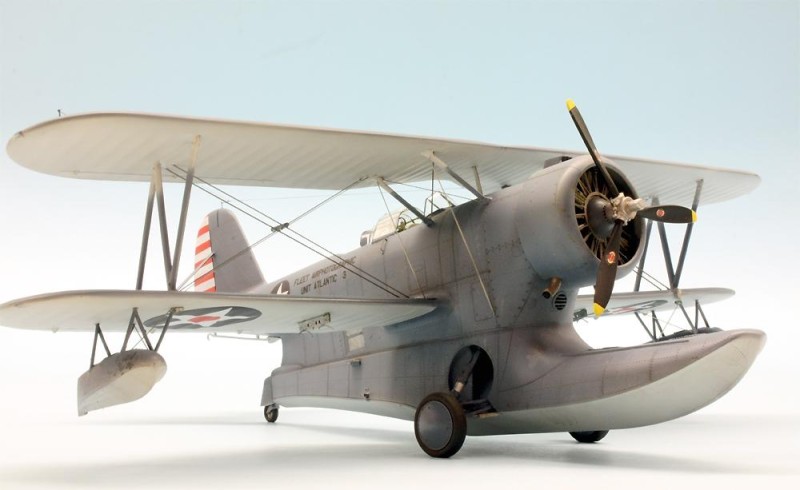
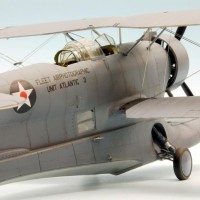
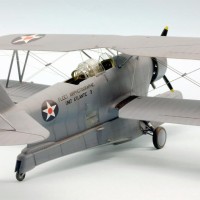
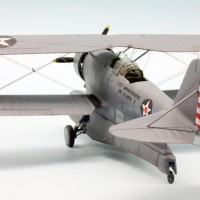
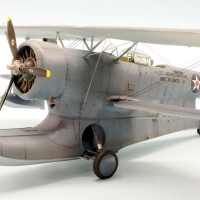
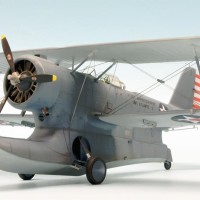
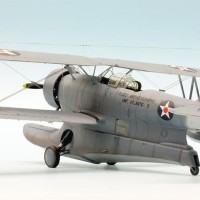

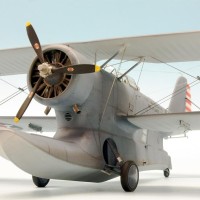
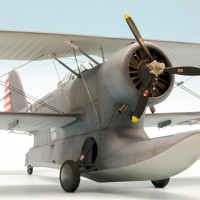

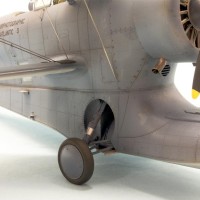
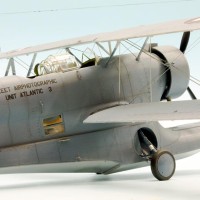
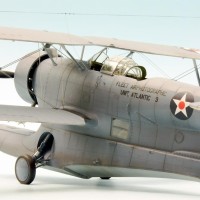
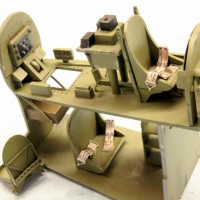
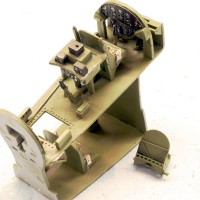
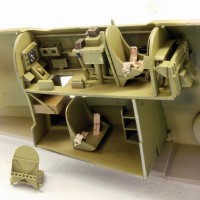
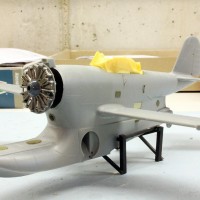
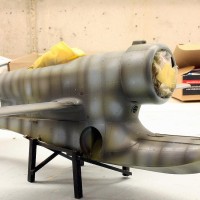
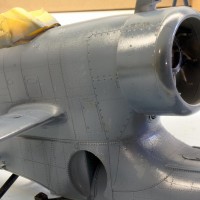

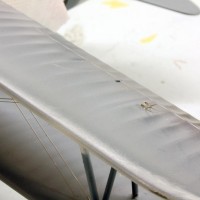
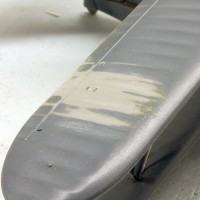

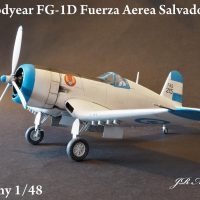
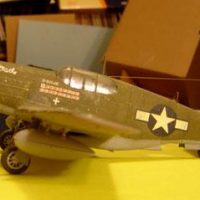
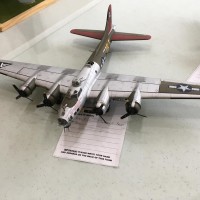
A truly wonderful build, up to your usual standards, Roland!
I love the Duck shape and your model represents it in the best possible way.
The historical text was also wonderful, I really like the way you write.
Congratulations!
Your words are really motivating, thank you my friend!
Great looking build, Roland. Well done!
Thanks a lot!
Splendid model! You really made the most of it. Always loved the looks of it and the office space taking up two whole floors.
This is an awesome build, Roland @rosachsenhofer
The Duck is an exceptional aircraft and has "weird" but great looks.
Everything on this build is of high standards.
Absolutely "Liked"
Fantastic presentation, and wonderful work all around. I particularly like your method for the rigging, and also how you made the monochrome paint interesting. Liked!
Beautiful job on this Roland! I never heard of "I Love Kit",
I Love Kit and Merit are both somehow another off-shoot of Trumpeter, as with HobbyBoss. Frankly, I don't understand the business, but the ILK Duck is easier to find here in the states than the previous Merit version, so that's a plus.
Super cool, Roland (@rosachsenhofer). The Duck has always been one of my favorites. Thanks for showing the various decks in the cockpit, since you never really see the lower deck once you put the fuselage together.
Wow!
That's imply outstanding! You definitely brought that kit to life!
phil
Man, you build fantastic scale models Roland! And here we have another beautiful example; please take a bow for this one! 🙂
Outstanding Duck Roland.
Stunning! I had no idea this kit even existed, and even knowing I will never build one, can’t help to admire how beautiful your rendition of the real thing is. Thumbs up twice
Fantastic job! There's at least one still flying, I saw it on the net, it's pretty agile.
Most likely would've appeared at the Chino Airshow that was going to take place at the end of October this year but has now been cancelled. It has appeared at this show previously.
The weathering is extremely well done!
🙂 ... Greetings ... 🙂 :
This model is a very immaculate and outstanding build Roland !
A very rarely seen subject, yet here it is as a show stopper.
Nicely detailed and a touch of subtle weathering.
Good work on the rigging, really makes this one pop out.
Thank you for sharing this one with us.
Yet another outstanding post from you, Roland, yet another aircraft I’ve never heard of, and superbly brought to life by your immaculate modelling. Definitely liked.
Thank you to all: it is quite unbelievable how your interest and your comments please me; thank you very much for that, it strengthens and boosts my motivation!
Great work, Roland.
Nice !
If it looks like a duck and flys like a duck, then it must be a Grumman Duck !
Nice work!
Qhack qhack!
Excellent Duck Roland. Rare bird in kit form as well as in the real world. Excellent finish, just the right amount of weathering of a plane at work at sea. Thanks for sharing and for the history of the Duck.
Smashing ! You probably didn't have to do as much scrounging as I did with Murphy's old Flyin' Lavatory.
I remember that build.@namregoob.
Excellent model on every count. You have my absolute admiration with the immaculate rigging; something which I've never quite managed to my own satisfaction. I also note that the vac form canopy allows for stacking on the sliding sections. An impossibility with the moulded parts. Top class Roland. Thanks for all the background information too!
Great! This convinces me to go buy this one kit.
All has been already said above. Bravo!
Great looking Duck - especially love the care you took with the paint and weathering work to get a nice realism to the mono finish. Well done!
Thank you all very much, I am honoured and delighted, thank you for this verbal support and encouragement!